How to choose pool fins?

For athletes in the pool, the choice of swimming fins plays an important role. They not only help to increase the strength of the legs, but also correctly stretch the ankle, and in some exercises, for example, swimming without hands, they are completely irreplaceable. However, in order for this device to be really useful for training, you need to understand how to choose it correctly. We will talk about all the subtleties and nuances of this process in our article.

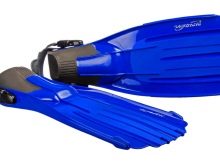
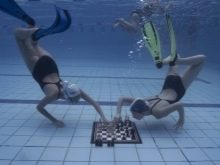
Peculiarities
Swimming fins are a special accessory that athletes put on their feet during exercise. Visually, you can notice their resemblance to a fin. Some people call this training attribute an engine, since it can be used to significantly increase the speed of movement in the water. Fins consist of a section for the foot and blade.
The use of fins for sports swimming in the pool allows you to promptly give the body the desired position.
The muscles will be provided with the necessary load, so the technique is being honed, and this applies to different styles.
However, this does not mean at all that training should take place exclusively with the use of this device. In everything, you need to know when to stop so that muscles, joints and ligaments develop from all sides.
When it comes to sports, speed is an important factor. This is especially true for sprinters, whose main task is to cover the distance in the shortest possible period of time. In order for the results to be satisfactory, special attention must be paid to training. Most often, short fins are used on them, and this is not surprising.
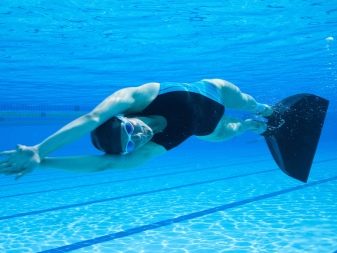

The fact is that fins of this type help to hone various swimming techniques. With their help, it turns out to exclude unnecessary activity in the knees, since the legs begin to work from the hip.
Rarely enough, the foot is naturally flexible. You can develop her mobility with the help of physical exercises, however, training with fins is currently the most effective in this regard. Water exerts increased pressure on the joints of the feet, which contributes to their accelerated development.
It should also be noted that physical fitness improves significantly when using fins. The fact is that moving in water, especially at a significant speed, requires the use of a large number of muscles, respectively, the effect is not only on the legs. For this reason today fins are used as a kind of simulator. However, in order for them to play a truly beneficial role, their choice must be approached with the utmost responsibility, having studied all the important aspects.
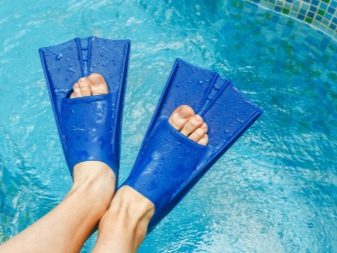
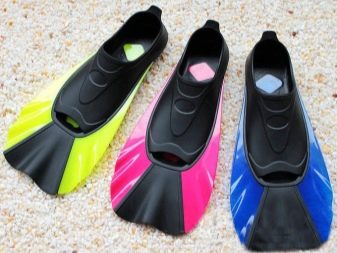
Forms
The shape of the fins can be different. For those who like to dive from a height, it is recommended to use closed heel fins... Open ones are more practical, as they can be used by people with different leg sizes, however, they are not always convenient for the pool.... Wide and flexible models as well as compound reduce the load on the legs. Short ones will help the athlete to improve his technique.
Those who prefer to develop serious speed should stop their attention. on long and narrow items.
For lovers of more natural movements, models are suitable with a forked blade. If the goal is to improve technique and strengthen various muscle groups, it makes sense to choose monofins, which are sometimes called fishtail.
As for the sock, it can also be as open and closed. Experts recommend choosing the first option as more convenient and practical. Fins of this type are especially often chosen for training.
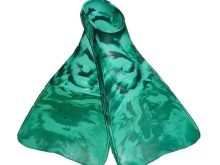
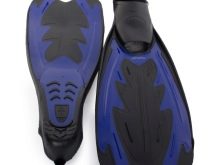
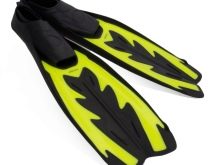
Dimensions (edit)
So, after an understanding of the purpose and type of accessory is reached, you should decide on the size. There are also nuances in this direction.
The issue of size is not so relevant for fins that do not have a backdrop. The size changes by adjusting the strap, and sometimes quite dramatically. The result is a perfect fit. Sometimes it makes sense to use bots. The main condition is the absence of discomfort from squeezing the foot.
Athletes often opt for closed heel fins.
When choosing them, it should be borne in mind that the model should be slightly larger than necessary.
Measuring this is quite simple - a toe should enter between the heel and the back surface.
This will provide comfort and help to avoid the likelihood of seizures. However, the main thing is not to overdo it, otherwise the product may simply fall off its feet. If the heel counter is made of a hard material, be careful not to rub it against your skin.


It should be said that these attributes are produced with a running start of 2-3 sizes. The user can choose fins for sizes 26-29, 36-38, etc. There are special mini models designed specifically for children. However, at the same time, there is a risk of acquiring small sizes, since manufacturers often have their own dimensional grid. That's why if possible, it is imperative to measure the product... If the order is made on the website, the moment should be checked with the supplier.
There are situations when you need to choose between two models, one of which is rather tight, and the other is looser. In this case, you should opt for the second option. The fact is that a tight model is much more likely to start chafing your skin. In addition, the water will help create an additional “water sock”. However, the main thing is not to overdo it, the models dangling on the leg are not a worthy choice. Better to postpone the purchase altogether.
Fins can be short or long. Each of them has its own characteristics.

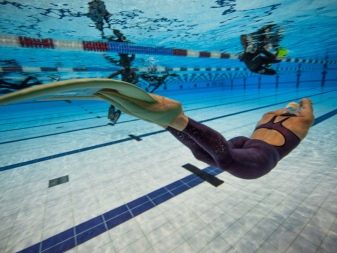
Short
This option is most often chosen for themselves by athletes involved in the pool. The short length has its own advantages, for example, it is very convenient for performing various maneuvers. Their main purpose is not to further increase speed. In this case, the focus is on improving swimming technique, during which the body maintains the correct position.
Such fins are most often made of rubber and plastic. Experts recommend choosing softer models for training at shallow depths, and hard ones in order to practice sharp maneuvers. The length of the products is usually from 50 to 65 centimeters.



Long
If the task is not swimming as such, but moving in the water and staying in it for a long time, as well as diving, you should opt for long models. They can be different from each other and are used for different purposes.
Long fins are just for swimming in the pool. They are also convenient to use at sea. Are an irreplaceable thing for diving.
Also for diving, and besides it, for activities such as, for example, spearfishing, very long fins are used.
Especially long pieces are great for freediving.
I must say that the length of the fin is directly related to the ease of movement in the water... Longer patterns have a greater effect on the muscles. If the swimmer does not have sufficient training, he should stop his attention on shorter devices. Some people advise beginners to use long fins, but this theory has many opponents.
The size of long fins can be from 80 to 95 centimeters. These indicators can be increased in individual cases. There are also more modest models with a length of 65-80 centimeters.
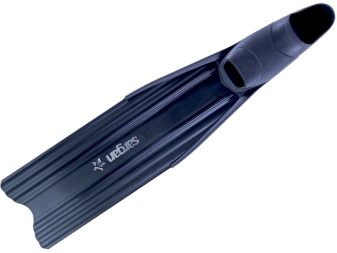
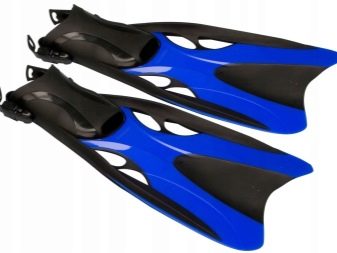
Materials (edit)
Manufacturers offer products from a wide variety of materials. Among them are plastic, rubber, silicone, carbon and others. However, the most popular are rubber and silicone models. They are also most optimal for use in pool workouts.
The fact is that such fins do not have sharp edges, so that their use does not pose a threat of injury to others in case of accidental contact. They are also more flexible, which is an added benefit for sporty swimming. Moreover, some pools prohibit those involved in using plastic models that have sufficiently sharp corners.
Products made of silicone have a higher cost, however users say they are much more convenient. Rubber can chafe the skin and can also contribute to allergic reactions. Plastic models help to move forward more actively, as they have greater rigidity, but additional effort is expended.
Products fiberglass and carbon are lightweight. This allows you to quickly dive into the water. Training in the pool with such fins can be problematic.
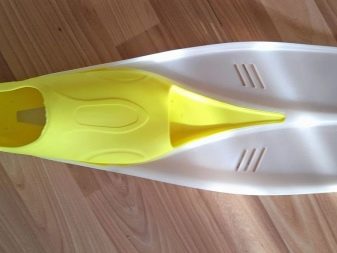
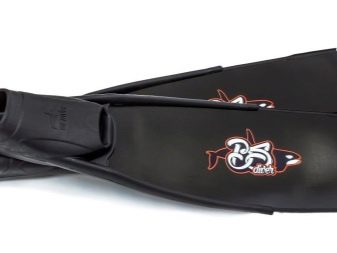
Which one is better to choose?
The choice of fins directly affects the performance of the athlete. According to research, this figure can increase by 20-30%. When buying, swimmers do not primarily pay attention to the appearance and design of the product; these points are important, mainly for beginners. This attribute is made in strict accordance with the results of the research.
It should be noted that all the details matter. That's why it is necessary to pay attention to various points, from the material of manufacture to the design.
The main argument when buying should be the convenience of the model. Also, we must not forget that the size should always be one more. Before purchasing, you must try on the product, leaving it on the foot for 5-10 minutes. This will help you understand if the overshoe is squeezing your foot. This moment is extremely important, as it affects the blood circulation, and if it is disturbed, there is a risk of seizures, which are absolutely unacceptable when on the water.
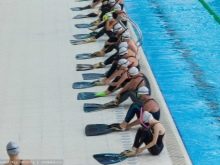
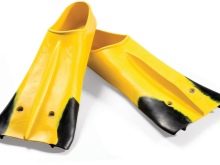
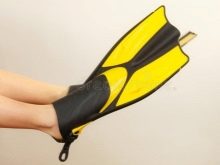
Fins should be chosen depending on the purpose.
For example, if a person is diving, it is best to use split models.
They will help reduce the strain on your muscles. You can also choose a product that allows you to change the blades. It is suitable for those who are interested in a variety of swimming styles.
Convenience also depends on how securely the fins are fixed on the leg. Experts do not recommend purchasing models with an open heel on a strap for training in the pool. Also, don't forget about the sole. Its unintentional sliding can cause all sorts of injuries, therefore it is best to stay on the grooved version.
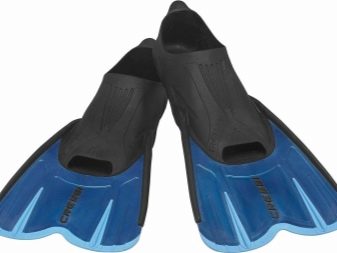
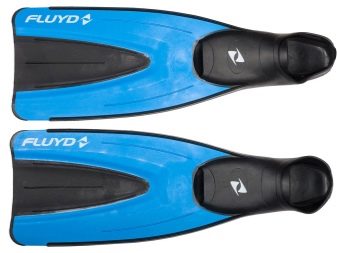
You can learn how to properly put on fins on your feet from the video below.








